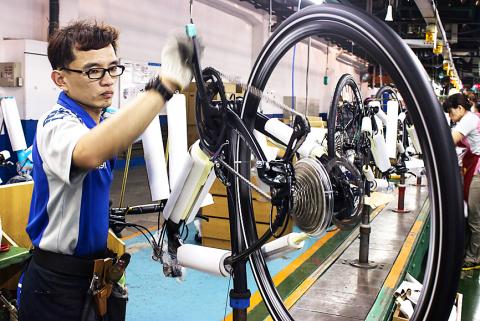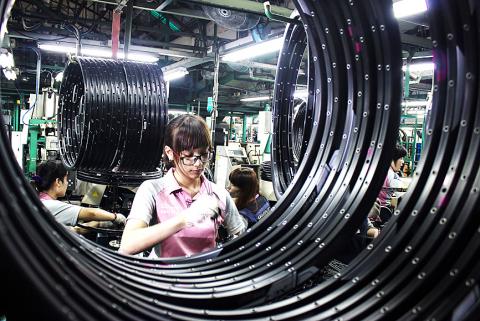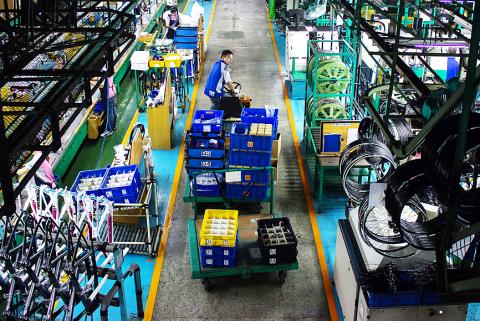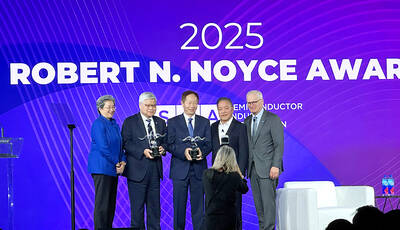Among professional riders and cycling magazine reviewers, the Propel, which retails in the US for between US$2,200 and US$9,000 depending on the model, is more than a high-performance racing bicycle — it is an engineering marvel.
It is so light you can lift it with one hand. It is so fast, promising to shave 12 to 36 seconds off race times over 40km, that it was picked by German rider John Degenkolb for a final sprint in this year’s Tour de France.
The Propel, named Cycling Plus magazine’s bike of the year both this year and last, is not the handiwork of prestige Italian or North American firms such as Cannodale Bicycle Corp, Colnago Ernesto & C Srl, Cicli Pinarello SpA or Cervelo Cycles Inc. It is made by Taiwan’s Giant Manufacturing Co (巨大機械), the biggest bike manufacturer in the world, better known until recently as a contract manufacturer for Trek Bicycle Corp, Scott Sports SA and other bikes — not for its high-end carbon-fiber racing bicycles.

Photo: Maurice Tsui, Bloomberg
“I think Giant’s technical prowess and abilities are amongst the very best in the whole industry,” said Warren Rossiter, senior technical editor for road for the London-based magazine group that publishes Cycling Plus and Bikeradar, and whose team tests more than 200 bikes per year.
“Giant may lack the cachet of historic Italian or American innovators like Cannondale, but for those in the know, the Giant brand represents truly cutting-edge design and technology,” he added.
However, while serious enthusiasts now recognize Giant’s engineering and design chops, casual riders have not always — some even spray-paint away Giant’s logo on the frame. So to improve its image overseas, Giant is planning an expansion in the US, from the 125 bike shops now offering Giant bikes as at least half of their inventory to 155 by the end of next near, adding to the almost 1,000 stores that carry Giant bikes in lesser proportions with other models.

Photo: Maurice TsUi, Bloomberg
Giant USA in September also began rolling out its bike fitting system in 10 stores, such as its southern California location on Santa Monica beach, and plans as many as 250 within five years, according to Giant USA general manager John Thompson.
For the first time, during this year’s Tour de France, Giant ran 65 TV commercials on NBC, he said.
Still, Giant wants consumers to know that its selling strategy is based on quality, not flash.

Photo: Maurice Tsui, Bloomberg
Anthony Lo (羅祥安), the CEO over three decades, said he realizes Giant is “not as sexy as some of the [other] brands.”
He said in a 90-minute interview in a bike workroom at headquarters in Taichung that the brand’s image is improving, because innovation speaks for itself.
“Strategy-wise, we have no intention to become just a very fancy brand,” he said. “Our root is still technology and quality.”

Photo: Maurice Tsui, Bloomberg
Sales in the US were up by 13.8 percent in the first half of this year compared with the same period last year, according to data provided by Giant.
They were up by almost 7 percent in Europe in the period, despite the drop in value of the euro.
The only place they were falling is in China, Giant’s biggest market, where an 8.5 percent decline in the first half can be blamed on a slowing economy.
Giant’s global sales of about NT$60 billion (US$1.82 billion) last year, up by 10.4 percent from 2013, were helped by the fact that it also contract-manufactures brands it is competing against. At its high-end factory in Taichung that can make more than 2,000 models and turn out 5,000 bikes per day, Scott and Trek frames can be seen coming off the same assembly line that produces Giant-branded bikes. Colnago bikes are made by Giant, too.
That does not mean they are the same — the companies themselves provide designs, specifications and some parts. Giant provides the manufacturing and workers — and reaps the benefits of their sales, too. Revenue of NT$47.3 billion as of the end of September puts the company on track to report a 4 percent increase this year.
Manufacturing for others, known as original equipment manufacturing (OEM), “helps us understand the overall market situation. It helps our management do planning and not make silly mistakes,” said Giant chairman King Liu (劉金標), who founded the company in 1972.
A still-robust 81-year-old, he has ridden his bicycle 2.5 hours either to the office or home every day for years and continues to do so. Liu said he plans to step down next year and hand over to a successor, leaving behind a solid foundation for continued growth.
“I think Giant is the best- positioned right now of any company in the global bicycle business, because of the combination of the OEM business and its brand positioning,” said Jay Townley, a partner in the Gluskin Townley Group, a US consultancy that researches the bicycle market for clients such as the US’ National Bicycle Dealers Association.
Lo, 66, believes there is no conflict. If bike manufacturers can simply convince more people to buy bicycles, all companies can grow, he said.
Based on global bicycle sales, Lo calculated that only a small percentage of people in the world ride a bicycle, roughly 18 percent. He calls himself a “missionary” who can introduce them to the healthy and healing powers of cycling.
“They need to be saved,” he said.
Road surface and gradation, the technology of the bike, a rider’s size, strength and length of their arms and legs — all of those make up what Lo calls “cycling science,” which means getting the rider the best ride possible.
In addition to five frame sizes to fit different riders’ heights, Giant offers even casual riders its fitting system to adjust bikes to their needs. While other brands offer such systems, Giant’s costs considerably less, Thompson said.
Giant’s lowest-cost bikes start from about US$330, with aluminum frames rather than carbon fiber.
“We’re trying to create more cycling fun in the way we present our brand,” said Thompson, who called Giant “the best kept secret in the bike business. That’s changing rapidly as we tell our story.”
Innovations have helped. VeloNews, which performs Consumer Reports-like testing, scored the Propel a perfect 30 out of 30 in the magazine’s evaluations of the fastest and strongest bikes in the world, the first to achieve its highest scores on both.
Giant put brakes behind the wheel forks to decrease drag, and strengthened the handlebar post to reduce wobbliness at high speeds.
Women are also a new target market. Giant sells racing bikes, branded as Liv, that are designed especially for women’s bodies, rather than just producing smaller frames painted pink or lowering the cross bar as other brands have done.
In the US, Giant has 80 Liv ambassadors — women who lead bike tours and host events — and there are dedicated Liv stores in Taiwan, Dubai and Shanghai.
“I think women really deserve to have their own bike,” Lo said. “You cannot take a men’s bike and make it smaller. That’s wrong. So we are doing it from zero.”
Liv bikes now set the standard for women’s cycling equipment, according to Cycling Plus’ Rossiter.
Another Giant bike, Defy, won his bike of the year previously, and was a five-time Bicycling magazine editor’s choice award winner as well.
Now Giant just needs its brand image to match its quality, Rossiter said.
“Made in Taiwan” is a loaded phrase filled with echoes of a less-technological past. It is time to move beyond it.
“Perhaps the perception is that the brand doesn’t have the soul or heritage of the old European marques, and that they don’t shout as loudly as American or German brands when it comes to technical innovation,” he said. “If anything, I believe it may be a cultural issue, that they don’t promote their strengths as well as other brands.”
With all the accolades Giant is now receiving around the world, Lo said, does it have to?

Shiina Ito has had fewer Chinese customers at her Tokyo jewelry shop since Beijing issued a travel warning in the wake of a diplomatic spat, but she said she was not concerned. A souring of Tokyo-Beijing relations this month, following remarks by Japanese Prime Minister Sanae Takaichi about Taiwan, has fueled concerns about the impact on the ritzy boutiques, noodle joints and hotels where holidaymakers spend their cash. However, businesses in Tokyo largely shrugged off any anxiety. “Since there are fewer Chinese customers, it’s become a bit easier for Japanese shoppers to visit, so our sales haven’t really dropped,” Ito

The number of Taiwanese working in the US rose to a record high of 137,000 last year, driven largely by Taiwan Semiconductor Manufacturing Co’s (TSMC, 台積電) rapid overseas expansion, according to government data released yesterday. A total of 666,000 Taiwanese nationals were employed abroad last year, an increase of 45,000 from 2023 and the highest level since the COVID-19 pandemic, data from the Directorate-General of Budget, Accounting and Statistics (DGBAS) showed. Overseas employment had steadily increased between 2009 and 2019, peaking at 739,000, before plunging to 319,000 in 2021 amid US-China trade tensions, global supply chain shifts, reshoring by Taiwanese companies and

Taiwan Semiconductor Manufacturing Co (TSMC, 台積電) received about NT$147 billion (US$4.71 billion) in subsidies from the US, Japanese, German and Chinese governments over the past two years for its global expansion. Financial data compiled by the world’s largest contract chipmaker showed the company secured NT$4.77 billion in subsidies from the governments in the third quarter, bringing the total for the first three quarters of the year to about NT$71.9 billion. Along with the NT$75.16 billion in financial aid TSMC received last year, the chipmaker obtained NT$147 billion in subsidies in almost two years, the data showed. The subsidies received by its subsidiaries —

Taiwan Semiconductor Manufacturing Co (TSMC) Chairman C.C. Wei (魏哲家) and the company’s former chairman, Mark Liu (劉德音), both received the Robert N. Noyce Award -- the semiconductor industry’s highest honor -- in San Jose, California, on Thursday (local time). Speaking at the award event, Liu, who retired last year, expressed gratitude to his wife, his dissertation advisor at the University of California, Berkeley, his supervisors at AT&T Bell Laboratories -- where he worked on optical fiber communication systems before joining TSMC, TSMC partners, and industry colleagues. Liu said that working alongside TSMC